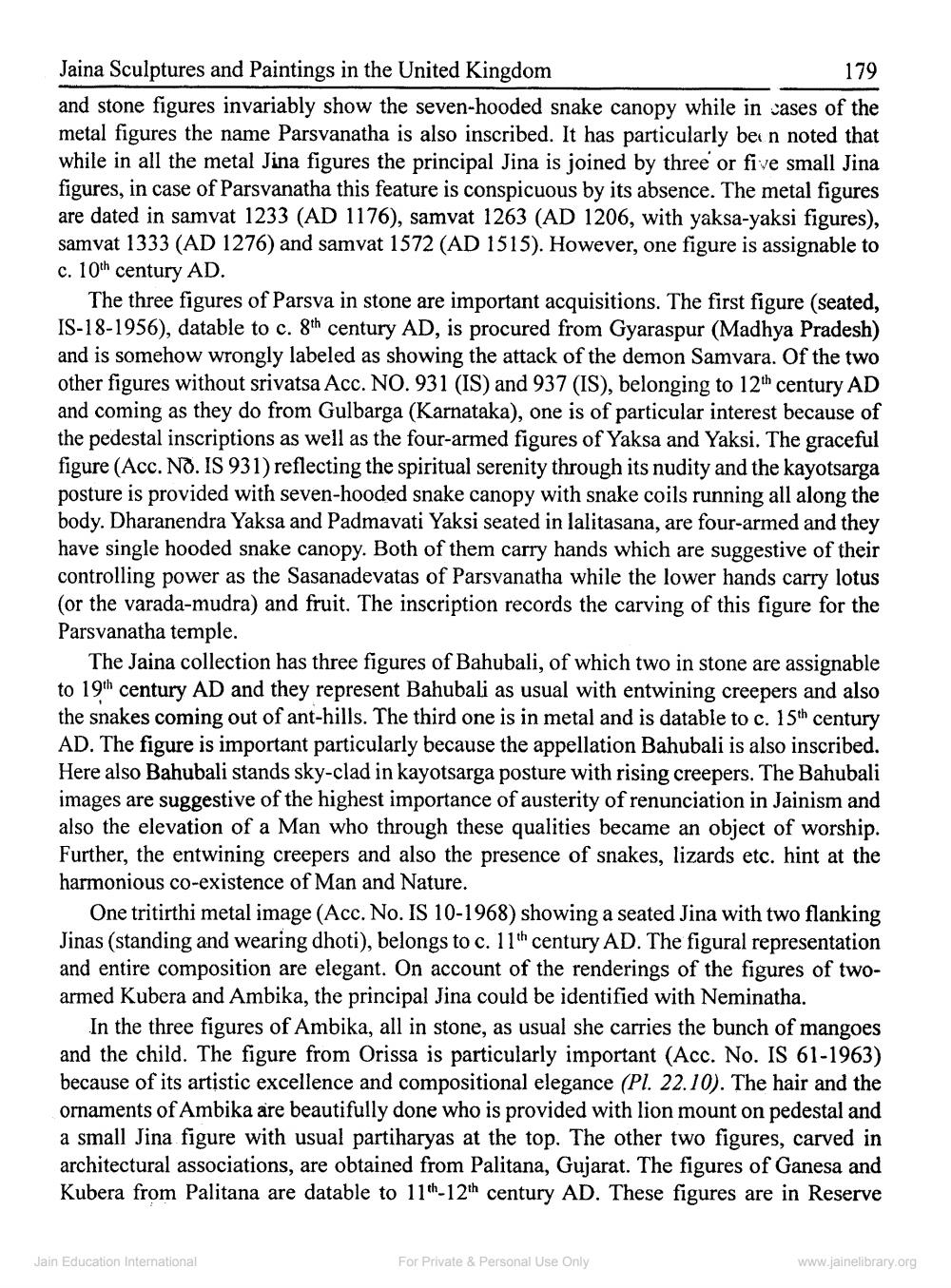________________
Jaina Sculptures and Paintings in the United Kingdom
179 and stone figures invariably show the seven-hooded snake canopy while in cases of the metal figures the name Parsvanatha is also inscribed. It has particularly been noted that while in all the metal Jina figures the principal Jina is joined by three or five small Jina figures, in case of Parsvanatha this feature is conspicuous by its absence. The metal figures are dated in samvat 1233 (AD 1176), samvat 1263 (AD 1206, with yaksa-yaksi figures), samvat 1333 (AD 1276) and samvat 1572 (AD 1515). However, one figure is assignable to c. 10th century AD.
The three figures of Parsva in stone are important acquisitions. The first figure (seated, IS-18-1956), datable to c. 8th century AD, is procured from Gyaraspur (Madhya Pradesh) and is somehow wrongly labeled as showing the attack of the demon Samvara. Of the two other figures without srivatsa Acc. NO.931 (IS) and 937 (IS), belonging to 12th century AD and coming as they do from Gulbarga (Karnataka), one is of particular interest because of the pedestal inscriptions as well as the four-armed figures of Yaksa and Yaksi. The graceful figure (Acc. NO. IS 931) reflecting the spiritual serenity through its nudity and the kayotsarga posture is provided with seven-hooded snake canopy with snake coils running all along the body. Dharanendra Yaksa and Padmavati Yaksi seated in lalitasana, are four-armed and they have single hooded snake canopy. Both of them carry hands which are suggestive of their controlling power as the Sasanadevatas of Parsvanatha while the lower hands carry lotus (or the varada-mudra) and fruit. The inscription records the carving of this figure for the Parsvanatha temple.
The Jaina collection has three figures of Bahubali, of which two in stone are assignable to 19th century AD and they represent Bahubali as usual with entwining creepers and also the snakes coming out of ant-hills. The third one is in metal and is datable to c. 15th century AD. The figure is important particularly because the appellation Bahubali is also inscribed. Here also Bahubali stands sky-clad in kayotsarga posture with rising creepers. The Bahubali images are suggestive of the highest importance of austerity of renunciation in Jainism and also the elevation of a Man who through these qualities became an object of worship. Further, the entwining creepers and also the presence of snakes, lizards etc. hint at the harmonious co-existence of Man and Nature.
One tritirthi metal image (Acc. No. IS 10-1968) showing a seated Jina with two flanking Jinas (standing and wearing dhoti), belongs to c. 11th century AD. The figural representation and entire composition are elegant. On account of the renderings of the figures of twoarmed Kubera and Ambika, the principal Jina could be identified with Neminatha.
In the three figures of Ambika, all in stone, as usual she carries the bunch of mangoes and the child. The figure from Orissa is particularly important (Acc. No. IS 61-1963) because of its artistic excellence and compositional elegance (Pl. 22.10). The hair and the ornaments of Ambika are beautifully done who is provided with lion mount on pedestal and a small Jina figure with usual partiharyas at the top. The other two figures, carved in architectural associations, are obtained from Palitana, Gujarat. The figures of Ganesa and Kubera from Palitana are datable to 11th 12th century AD. These figures are in Reserve
Jain Education International
For Private & Personal Use Only
www.jainelibrary.org




